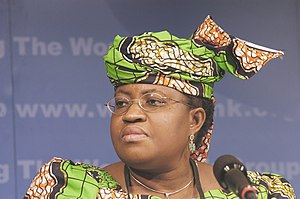
Ngozi Okonjo-Iweala (Finance Minister of Nigeria, 2003-2006; Managing Director of the World Bank, December 2007-present of May 2010), at the 2004 Spring Meetings of the International Monetary Fund and the World Bank Group. (Photo credit: Wikipedia)
One of the more interesting aspects of the last global financial and economic crisis was the way in which banks’ health, public finances, and countries’ output became almost inextricable intertwined. The most obvious thread in this link was that between banks’ holding of sovereign debts and the effect on these of the ensuing sovereign fiscal crises. As governments’ finances worsened, and concerns rose over their ability to sustainably meet their obligations the value of these assets on the banks’ balance sheets quickly deteriorated.
This was not the only channel, though, through which banks’ balance sheets and public finances looped in on each other. For, as concerns heightened over individual countries’ ability to meet their obligations, even the assurances that the markets had come to expect from governments’ regulation and supervision of banks was not worth much any longer. Public finances thus drove both bank runs, and aridity in the interbank markets. How much were bank-held collaterals worth subsequently? Not much! Especially when financial services institutions, themselves, inherited the effects of sovereign credit downgrades.
In most cases, this relationship between banks and their sovereigns continued post-crisis; with subsequent bank bailouts leaving gaping holes in public finances. In what is arguably the most odious example, Ireland’s bailout of its financial sector (estimated at around 40% of GDP) was a major contributor to the worsening of its deficit. Invariably, post-crisis attempts at remediation have concentrated on weakening these adverse feedback links between banks and their sovereigns. Or, rendering the links a lot more tenuous.
The Nigerian economy is unique in many respects. Its sundry diseconomies guarantee that the links that work elsewhere, the transmission mechanisms on which systems are based just do not function at all. Thus, it is regularly insulated from global stress events. In the particular example of the last crisis, because global oil prices were not as in thrall to the diverse stress events as most analysts had predicted, our economy was spared even the disruptions through this “bank-sovereign” channel. Still, the economy has another attribute peculiar to it: its penchant for being wagged furiously long after the global mutt suffers the creeps.
When the Central Bank of Nigeria (CBN) moved, last month, toughening the weights used for calculating banks’ capital adequacy ratios, it did so obviously out of concern to prevent the buildup of the kind of bank exposure to public finances that regulators elsewhere have come to hold responsible for the adverse feedback loop between banks, public finances, and output growth. Was the CBN justified in its disquiet? What is the true character of the current relationship between banks and the public sector in Nigeria?
Much has been made of banks’ holding of treasury bills. How for instance monies that should be driving private sector credit growth ends up supporting the federal government’s new bulimia for borrowed money. But rarely does bank lending to sub-national (states, largely) governments make the headlines. The trouble with lending to the federal government is past moot. Without any doubt, government borrowing prevents money going the private sector’s way. However, what government does with the borrowed funds matters more than how it sources the monies. Spent maintaining or acquiring new roads, bridges, power infrastructure, fibre-optic networks, etc. government spending could drive rapid output growth, and result in net welfare gains for us all. Spent, on the other hand, on “recurrent” items, chances are that all such government spending does is drive inflation up.
Incidentally, of our huge recurrent expenditure bill at the federal level, only about half of it goes to meeting the federal government’s wage bill. The rest is spent on stationery, fuel, furniture and fittings, etc. The monetary authority is then forced to push the policy rate up in a bid to hold prices steady. The higher rate bids up the yield on government debt, inviting further financial sector interests in these instruments. A classic vicious cycle!
Interestingly, inflation is the tool of last resort available to the federal government for managing its debt. Once it decides to print money to pay these debts (a sovereign’s prerogative) domestic prices come under additional pressure. States, alas, are not permitted this sleight of hand. If, then, they borrow from banks, and proceed to squander it after the federal government’s example, what is to be done? This question is more pertinent today, when a good many states in Nigeria are near broke.
